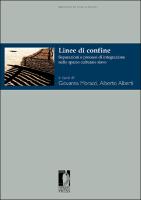Linee di confine
Separazioni e processi di integrazione nello spazio culturale slavo
| dc.contributor.editor | Moracci, Giovanna | |
| dc.contributor.editor | Alberti, Alberto | |
| dc.date.accessioned | 2022-05-31T10:20:36Z | |
| dc.date.available | 2022-05-31T10:20:36Z | |
| dc.date.issued | 2013 | |
| dc.identifier | ONIX_20220531_9788866555575_355 | |
| dc.identifier.issn | 2612-7679 | |
| dc.identifier.uri | https://library.oapen.org/handle/20.500.12657/55071 | |
| dc.language | Italian | |
| dc.relation.ispartofseries | Biblioteca di Studi Slavistici | |
| dc.title | Linee di confine | |
| dc.title.alternative | Separazioni e processi di integrazione nello spazio culturale slavo | |
| dc.type | book | |
| oapen.abstract.otherlanguage | The title of this volume refers to a reality which is often dramatically experienced, in different historical phases, by all the territories where Slavic cultures lived in contact with other ethnic groups. Beyond the problems of coexistence, which is additionally complicated today by phenomena such as globalisation and multiculturalism that disguise identity conflicts, the history of the Slavs has always been intertwined with that of other peoples. Therefore, it seemed appropriate to propose the recurrent theme of “borders”, which offers ample space for reflection on a multiplicity of aspects of Slavic cultures. Today Italy still looks at the countries of Central and Eastern Europe with a certain skepticism. The languages and traditions of this area remain little or not at all known. The migratory flows of the peoples in the past twenty years have contributed to creating the image of a backward Europe of secondary importance, which wants to impose itself on the Europe of primary importance. This collective volume, on the other hand, wants to show how we can strive to understand our identity as Europeans only by widening our gaze to the east and learning the lesson of the territories of Central and Eastern Europe. Even if the western Slavs and part of the southern Slavs have participated in western history since the Middle Ages and were then divided by historical events, a new European identity can be forged only by reflecting on the events of the entire Slavic world, and experiencing the same difficulties of coexistence (as is now also the experience of western Europe) between residents and immigrants, majority and minority cultures, identity and otherness. | |
| oapen.identifier.doi | 10.36253/978-88-6655-557-5 | |
| oapen.relation.isPublishedBy | bf65d21a-78e5-4ba2-983a-dbfa90962870 | |
| oapen.relation.isbn | 9788866555575 | |
| oapen.relation.isbn | 9788892734470 | |
| oapen.series.number | 22 | |
| oapen.pages | 594 | |
| oapen.place.publication | Florence |

